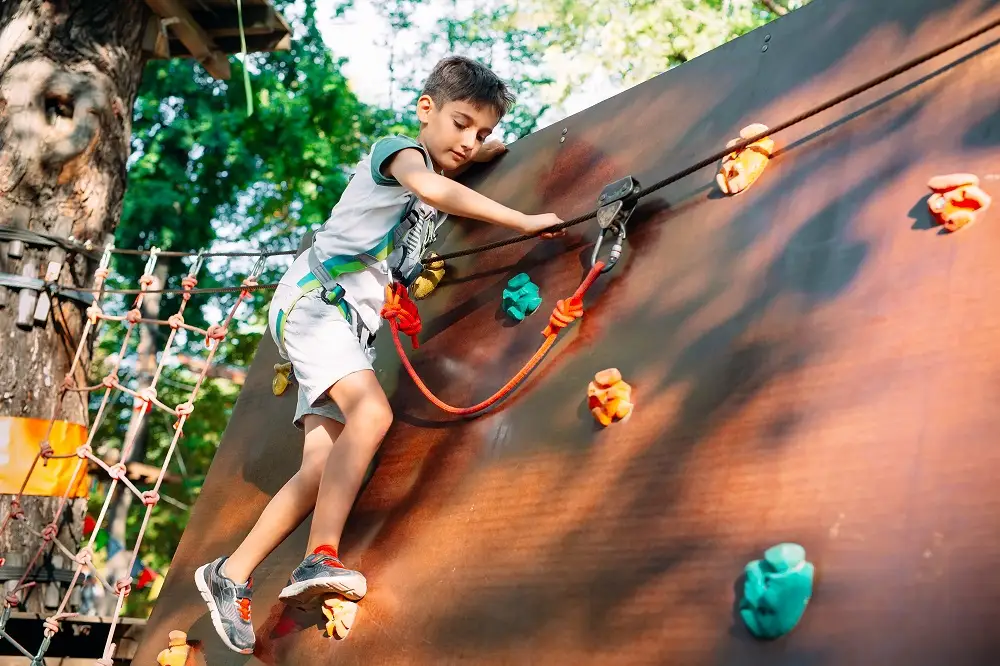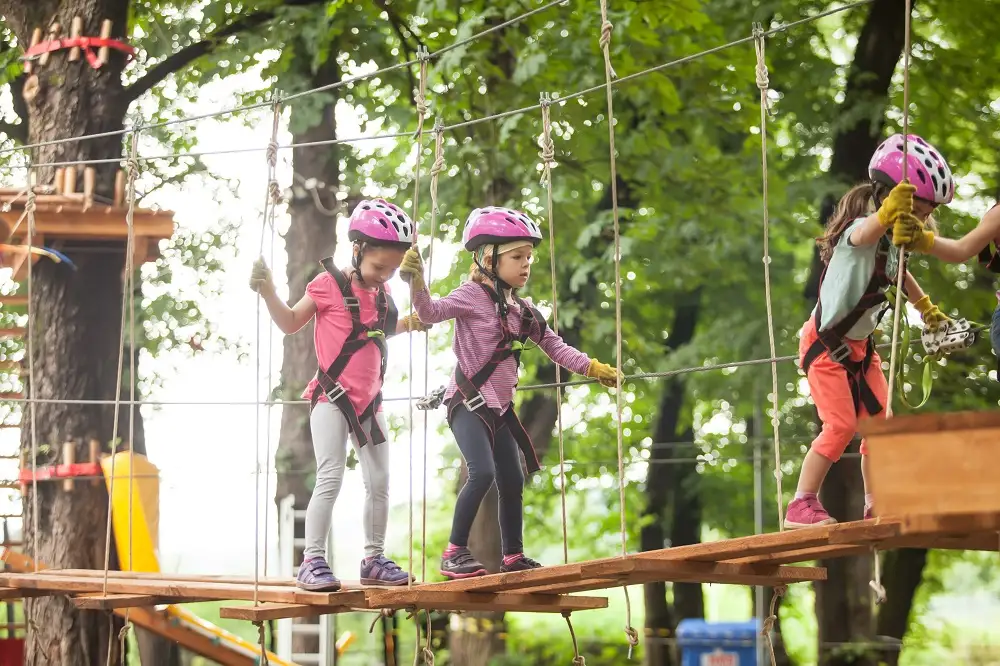In today’s digital world, parents face an increasingly difficult challenge: how to get children physically active while developing crucial life skills. Many kids spend hours in front of screens, missing essential developmental experiences. Yet, there’s a solution that transforms physical activity from a chore into an adventure: obstacle courses.
An obstacle course for kids combines physical challenges with cognitive puzzles, creating a developmental playground where children build strength, problem-solving abilities, and emotional resilience. Let’s ditch the endless screen time and explore how these dynamic experiences can transform your child’s development from a young age!
What Is an Obstacle Course for Kids?
Obstacle courses have surged in popularity, evolving into family-friendly activities embraced worldwide. In its simplest form, an obstacle course is a series of physical challenges children must navigate by climbing, jumping, crawling, balancing, or solving. They can be indoor or outdoor, fixed or improvised with household items, and obstacle course ideas are endlessly customizable based on age, space, and goals.
Unlike traditional playground equipment that focuses on a single skill (like swinging or sliding), obstacle courses integrate multiple movements and skills into a cohesive journey. Each obstacle presents a unique challenge — whether it’s traversing monkey bars, navigating balance beams, climbing cargo nets, or other obstacle course equipment — creating a complete developmental experience.
Benefits of Obstacle Courses for Children’s Development

Obstacle courses are undoubtedly fun and engaging. However, the value of incorporating obstacle courses into a child’s routine extends far beyond entertainment. They’re the foundation for a range of developmental gains that support physical, cognitive, emotional, and social growth.
1. Whole-Body Strength and Endurance
Crawling under nets, jumping between pads, and climbing over hurdles aren’t just fun — they’re serious physical challenges. These movements build functional strength, stimulate joint stability, and engage major muscle groups. Children develop endurance and improve over time as their stamina grows. They also build stronger postural control, essential for everyday movement.
2. Balance and Coordination Mastery
As children navigate balance beams, stepping stones, or swinging elements, they’re refining their vestibular system with balance skills developed through constant practice. This improvement in coordination skills creates stronger neural connections between different motor control centers, benefiting children in sports, playground activities, and even classroom tasks.
3. Enhanced Body Awareness and Motor Skills

A single course activates a child’s whole sensory and motor system. Fine motor skills come into play during activities like squeezing through tight spaces or grasping ropes. Gross motor skills develop when jumping, crawling, and running.
One of the most powerful aspects of obstacle training is that it develops both body and brain in tandem.
More than that, obstacle course training improves proprioception — our ability to sense where our body is in space. Children struggling with everyday tasks like writing, buttoning shirts, or staying upright on uneven surfaces benefit from the motor skill development baked into these activities. Plus, obstacle courses make the process enjoyable.
4. Superior Problem-Solving Abilities
Each obstacle presents a unique physical puzzle that children must solve in real-time, creating powerful cognitive development and problem-solving skills in a way that other activities cannot. Children approach these challenges with three key skills:
- Strategic thinking: Analyzing obstacles and developing plans for success.
- Adaptability: Adjusting approaches when initial attempts don’t succeed.
- Application: Transferring solutions between similar challenges.
5. Improved Memory and Spatial Intelligence
Successfully navigating an obstacle course strengthens the working memory as children remember obstacle sequences and recall effective strategies from previous attempts. They develop mental maps of the course, improving spatial reasoning as they calculate distances and heights — skills that directly transfer to academic subjects requiring visual-spatial processing.
6. Heightened Focus and Decision-Making

Navigating an obstacle course isn’t just physical — it requires laser-sharp attention. Children must make rapid decisions: Where do I step? Should I jump or duck? This active concentration sharpens focus and decision-making.
Research shows these activities benefit children with attention issues, including ADHD, by combining physical exertion with cognitive engagement. These are ideal conditions for developing concentration that transfers to academic settings.
7. Academic Readiness and Brain Development
When children engage in complex physical activities requiring balance and coordination, they strengthen neural pathways that directly support reading, mathematics, and problem-solving. Cross-body movements promote communication between brain hemispheres to build a foundation for integrated learning. This provides insight into the strong correlation between motor skills and academic achievement.
8. Building Confidence and Resilience
Perhaps the most valuable benefit of obstacle courses is developing psychological resilience. When facing challenging obstacles, children experience natural opportunities for failure in a supportive environment. Each successful navigation builds confidence through effort and persistence, developing a growth mindset that transfers to academic and social challenges.
9. Encouraging Teamwork and Communication

Does your child need a social boost outside of screen time? Obstacle courses are inherently social. Kids cheer each other on, take turns, communicate strategies, and sometimes team up. These experiences build empathy, communication competencies, and leadership skills. For kids who struggle with social interaction, these low-pressure group dynamics offer valuable practice in team-building activities.
10. Emotional Regulation Through Physical Activity
Running, climbing, and crawling release built-up energy. For many kids, physical activity is a natural form of emotional regulation. Obstacle courses also support sensory processing skills, giving children a chance to reset and calm their nervous systems. This is especially beneficial for kids who are sensory seekers or who benefit from sensory integration therapy — something therapists have incorporated into obstacle courses for years.
11. The Simple Power of Fun and Engagement
The inherent fun of obstacle courses sparks deep, lasting engagement. When children genuinely enjoy an activity, they’re not just participating — they’re immersed. That joy fuels persistence, encouraging them to push through challenges, try again after setbacks, and return for more.
These are life lessons they won’t forget. Obstacle course advantages go far beyond play; they prepare children for life.
This intrinsic motivation and the drive to explore, conquer, and succeed make obstacle courses powerful. Kids aren’t active because they’re told to be. They move because the challenge excites them. And that excitement becomes the gateway to stronger bodies, sharper minds, and confident spirits.
One Course, Endless Benefits
The beauty of obstacle courses lies in their comprehensive developmental impact. All it takes is one session for your child to start improving their physical strength, problem-solving, and emotional resilience. This holistic approach aligns perfectly with how children naturally learn: through movement, play, and progressive challenges.
At Mission Grit, we’ve helped countless children transform through our obstacle course programs. Our approach combines physical challenges with character development in our Xplor Program, birthday parties, team-building events, and camps. With over 600 unique activities, seven programs, and 290+ 5-star reviews, we are confident your child will thrive! Contact us today to experience the extraordinary benefits with our expert instructors!



